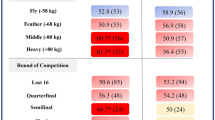Abstract
Starting with some considerations on the scoring system in an orienteering race used in Italy, the author examines the main aspects of the Elo chess ranking system in order to show how it can be adapted to orienteering, creating the OriELO system. The OriELO system is based on the ranking position and the quantification of the arrival time compared to the time estimated on the basis of the relative strength of the opponents. The basis of the Elo ranking system and the proposed OriELO system is the likelihood of a win or defeat in a direct confrontation, given by a logistic distribution. Here the theoretical explanation with formulas is followed by a simulation.

(source: ASD Polisportiva G. Castello sez. Orienteering)

Similar content being viewed by others
Notes
Level 2 coaches “are tasked with promoting the culture and practice of orienteering, giving basic courses, also at schools or sport-promoting institutions, training all federal technical officials” (art. 3.2.1 of the “Regolamento Quadri Tecnici”, last updated 15 January 2017) and they “operate in all outreach activities of orienteering: courses for beginners, school activities and events of a promotional nature” (art. 3.2.2 of the “Regolamento Quadri Tecnici”).
For the calculation of the LB score, for each athlete the average of the best five scores obtained in a season in all official competitions will computed (art. 6.4.1 of the “Regolamento Tecnico Federale”, last updated on 15 January 2017).
FIDE Rating Regulations (http://www.fide.com/fide/handbook.html?id=172&view=article).
See its description in Mark Glickman’s website: http://glicko.net/glicko.html.
The median of a series of n data sorted in an increasing way is the central value of the series, that is, the average value of the data in positions n/2 and (n + 2)/2 when n is even, or the value in position (n + 1)/2 with n odd.
References
Ciancarini, P.: Misurare le prestazioni agonistiche: il caso degli scacchi. Evento metrico GUFPI-ISMA. Università di Bologna, Bologna (2013)
Elo, A.: The Rating of Chessplayers. Arco, New York (1978)
Glickman, M.E.: Chess rating system. Am. Chess J. 3, 59–102 (1995)
Glickman, M.E., Jones, A.C.: Rating the chess rating system. Chance. 12, 21–28 (1999)
Weisstein, E.W.: Logistic equation. MathWorld—a wolfram web resource. http://mathworld.wolfram.com/LogisticEquation.html. Accessed 31 Oct 2017
Author information
Authors and Affiliations
Corresponding author
Rights and permissions
About this article
Cite this article
Aebischer, T. A new algorithm for the rating of orienteering athletes: the OriELO system (OE). Lett Mat Int 5, 313–321 (2017). https://doi.org/10.1007/s40329-017-0203-3
Published:
Issue Date:
DOI: https://doi.org/10.1007/s40329-017-0203-3




